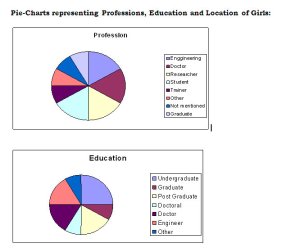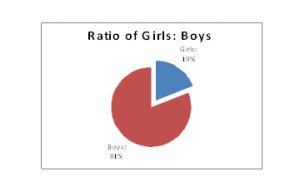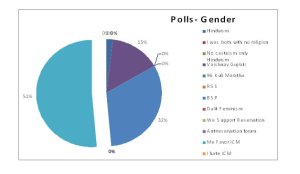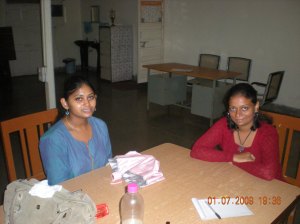We visited caste related Communities. (Orkut as an example of virtual social networking site). We had searched these Communities by going on the search engine of the Communities and then typed the word “Caste”, we came across hundreds of communities and so were confused. We thought of developing patterns and categories in order to make complicated things appears simpler to us. We made three broad categories viz. Caste and Caste related issues, Caste based reservations and Inter caste marriage.
We divided each broad category into two sub-categories- For and against.

Figure 1: Categorization of Communities
Selection of Communities for pilot study: While doing the selection we kept in mind that at least two communities belonged to each broad category. Selection was done randomly for each category. We studied 30 communities as our pilot data. When we started analyzing this data, we came across overlapping categories. We used Venn diagrams to represent this.
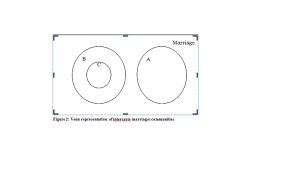
A: Against Inter caste Marriage
B: Supporting Inter caste Marriage
C: Want to go for Inter caste Marriage
Venn diagram Showing Overlapping Communities for reservation based on Caste

Members in Communities
A: Not supporting reservations
B: Not eligible for reservations
C: Supporting reservations
D: Eligible for reservations
Shared region between A and B: Members not supporting as well as not eligible for Reservations.
Shared Region between B and C: Members supporting reservations but not eligible for Reservations.
Shared Region between C and D: Members Supporting as well as eligible for Reservations.
Shared region between D and A: Members not supporting but eligible for reservations.

A: Supporting Hinduism but not caste System
B: Supporting Hinduism as well as caste System
C: Not Supporting Hinduism but not caste System
D: Not Supporting Hinduism but Supporting caste System
E: Hinduism
**In case of caste and caste based related Communities we took Hinduism as an Ideology and caste system as a part of it.
We had also kept a record of the trend in the mean increase of number of members per day.

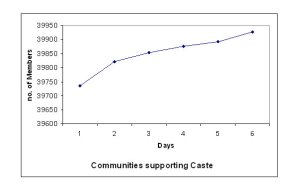

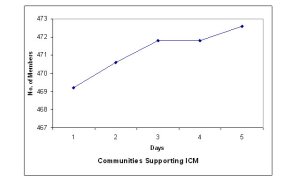

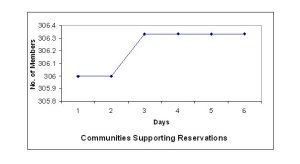
Observations and Conclusions from Pilot Study:
- In case of marriage, there are communities which are against Inter caste Marriage as well as Supporting Inter caste Marriage. In Supporting Inter caste Marriage Category there are very few people who actually want to go for Inter caste Marriage. So we reframed our previous category which was simply representing for and Against Inter caste Marriage. (Please see 1st Venn Diagram)
- In case of caste based reservations category, we realized that we cannot simply classify people’s views in for and against Category, so we had to think about overlapping 4 categories in addition to the existing 4 categories.
- From the graphs of the caste and caste system we saw a positive increase in no. of members.
- From the Graph of Inter caste Marriage Category, Against Inter caste Marriage, one shows no increase in members whereas that of supporting Inter caste Marriage shows a positive relation.
- So this trend clearly indicates constant increase in the members of community and hence the activeness of it.
- This led us to think that the trend in increase of members in each category could be done on weekly basis for actual research.
- We also realized the fact that Forums and Polls should also be studied in detail as there were lot of discussions on it related to caste and caste feelings.
Process of actual research:
When we started with an actual selection of communities for research, we found that the pilot study communities were not enough to get a clear picture. In order to do this we added the categories: Caste as an Identity, Caste & gender and Caste & Politics to already existing categories.
In our pilot study, we had studied religion related communities which confused us and so we realized the need of searching for Caste related communities. It was very difficult to find these communities by merely typing caste in search engine, so we had to type words like “Brahmins”, “Gujrati” etc. While investigating religion and caste related communities, we found some politically influenced communities in their related communities list, so we thought of exploring this component too. When we were trying our hand at searching Caste related communities, we came across “Dalit” Community and on further evaluation we came to know about communities like “Dalit Feminism”, “PANCHAMI Dalit women focus”, etc. We were interested to understand how women discuss issues of caste on Internet.
Searching for community according to our refined categories became troublesome as earlier we had looked for people’s opinion and not at the agenda of Community. It was very difficult to find communities which fit exactly into the categories as we couldn’t find a single community in some categories, so had to reform the refined categories. The refined categories were very idealistic and less of practical use. Hence we proceeded with simple previously formed categories.
Finalized List of Communities:
Hinduism as well as Caste System
- Hinduism
- Hinduism
- Hinduism
- The Hindu
- I was born with no religion
- No caste, no religion
- India SC/ST/OBC Minority Union
- No casteism only Hinduism
- Against the caste system
Caste as an identity
- Vaishnav Gujrati
- Deshastha Brahmin
- Brahmin tradition and culture
- The Great Maratha
- 96 Kuli Maratha
- Dalit
- Brahmin
Caste and Politics
- RSS Rastriya Swayamsevak Sangh
- I want to join RSS
- BSP- Bahujan Samaj Party
Caste and Gender
- Dalit femininism
- PANCHAMI dalit women focus
Reservation
- Scheduled Castes/Tribes
- We support reservation
- OBC/SC/ST’s against Reservation
- A positive look at reservation
- Engineers against Reservation
- Anti reservation forum
- I hate reservation
Inter caste marriage
- Me favour Inter caste marriage
- I love inter caste marriage
- I hate inter caste marriage
Others
- Against the caste Communities (on orkut)
We are keeping the statistics of weekly data of an increase in number of members in finalized list of communities.
Forums and Polls (F & P’s):
While browsing through F & P’s, we observed that some people are actively taking part in ongoing discussions whereas others are indifferent. We thought of visiting the active members profile and collected their demographic information (if put on Orkut profile). We selected two members from each community and documented the details along with the demographic information of the owner of the community and the community itself.
Merely counting the number of F & P’s was not giving a clear picture on topics of discussions. While we were reading F & P’s, we observed that there are unique patterns in most of them. We categorized F & P’s in 8 different categories as given below:
- Culture and traditions
- Religion
- God
- Caste system and Caste discrimination
- Gender
- Inter caste Marriage
- Politics
- Others (advertisements, introduction and interaction games, etc.)
It was very difficult to study all the F & P’s of all the 32 selected communities; therefore we selected 1 community from each category (the most updated one). We finalized 12 Communities for our further studies. Even in these 12 communities it was practically impossible to study all the F & P’s as the number of F & P’s in some communities were in thousands (e.g. RSS Community had Forums: 43880 and Polls: 440).
Thus for the sake of convenience, we set upper limit for forum as 100 and for polls as 50, the communities which were having less than above mentioned numbers, we studied all of them.Here the problem we faced was how to compare the numbers of F & P’s of one community to that of others as the total number we studied was not the same for all communities, so we came up with the idea of percentages.
Maintenance of data base:
When we were documenting number of girls and boys of 32 selected communities (taking 100 as maximum and those having less than 100, we counted all), we came to know that number of girls was lesser than that of boys in Caste related Communities. We were very curious to know the difference in numbers and so we calculated the percentage of boys and girls. It was surprising to know that only 19% were girls. Our interest made us study the demographic information of all the girls from our sample of Communities. The data which we collected was all in quantitative form and hence developed a questionnaire which will help us with Qualitative data.



